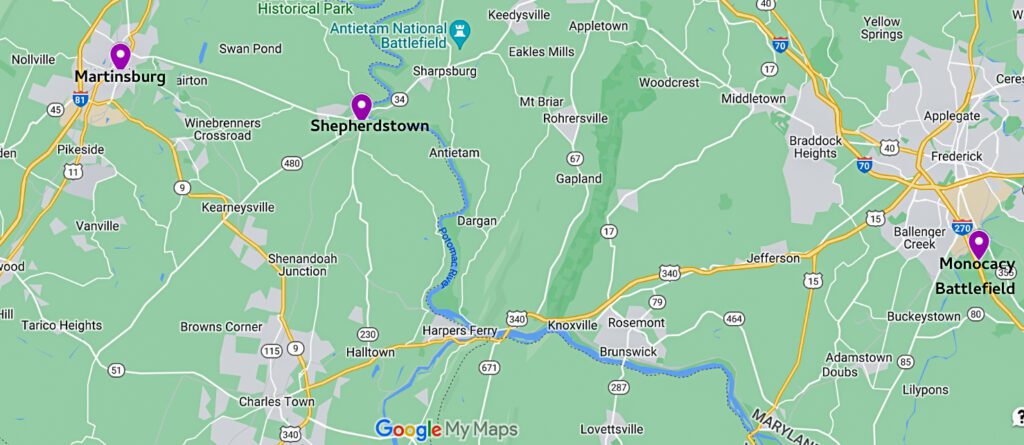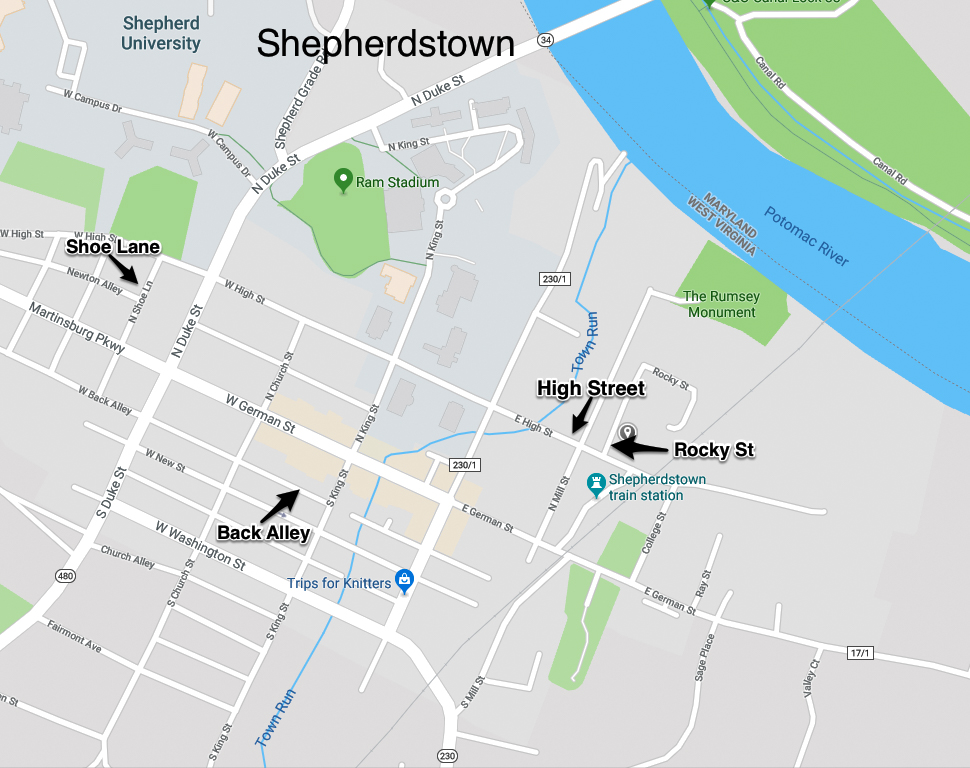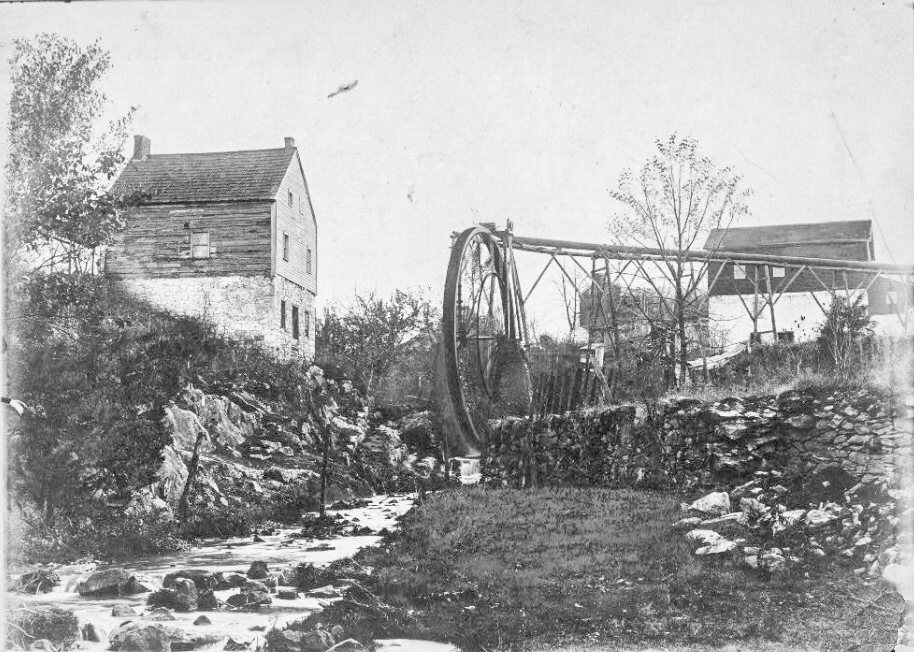Shepherdstown, West Virgina
Shepherdstown, West Virginia was originally established as Mecklenburg, Virginia in about 1734. The land was part of the 40,000 acre Virginia Land Grant obtained by John and Isaac Van Metre in 1730 for his family and friends. Much of the grant was sold to Jost Hite, but John and Isaac selected their portions of the grant for their immediate family.
Elizabeth Van Metre, the daughter of John and Margaret (Mollenaur) Van Metre, married Thomas Shepherd. They were instrumental in founding Mecklenburg, Virginia (now Shepherdstown, West Virginia), land that was obtained through the Virginia Land Grant.
Thomas and Elizabeth (Van Metre) Shepherd
Elizabeth was born in Somerset County, New Jersey about 1715. In 1733 she married Thomas Shepherd, the pioneer colonist, most likely in Prince George’s County, where Elizabeth’s family were still living at that time. Their settlement was located about where the current Monocacy Battlefield is. Soon after their marriage, they crossed the Potomac into the Colony of Virginia and settled upon the grant that Thomas Shepherd obtained in 1734. Thomas was possibly the son of William Shepherd and Sarah Cochran. Elizabeth inherited her father’s “Pell Mell”, located in Maryland directly across from the river from Shepherdstown. The Virginia (now West Virginia) property lies just west of the Potomac River and about a 30-mile drive east to Frederick, Maryland (just north of the Monocacy settlement.) Elizabeths parents settled in what is now Martinsburg, West Virginia.
Table of Contents

Current Map Showing locations of Martinsburg, West Virginia, Shepherdstown, West Virginia and the location of the Monocacy Battleground Memorial,just south of Frederick, Maryland. John Van Metre settled in Maryland in 1725 about where the Monocacy Battlefield is located, he then relocated in about 1735 to what is now Martinsburg, West Virginia. Thomas and Elizabeth (Van Metre) Shepherd established Shepherdstown.
Mecklenburg, Virginia 1730-1775
The settlement became known as Mecklenburg, although the town of Mecklenburg, Frederick County, Virginia wasn’t officially established until 1762 (West Virginia after 1863). Mecklenburg was renamed Shepherd’s Town in 1798, after Thomas Shepherd’s death (1776) in his honor. After the Civil War (1865), the town’s name was officially changed to Shepherdstown.
It is said that his first settlers were thrifty German mechanics. Whoever they may have been, they were encouraged by the enterprising energy of Thomas Shepherd, and an industrious community was soon developed. Then a fort was erected, for the times were full of menace, and the Indians were growing more restless and troublesome under the influence of the French parties who sought to control the commercial and territorial advantages along the Ohio. The Shepherd’s Fort came the settlers in times of danger, for protection, and it is no doubt due to these circumstances that Thomas Shepherd received the title of Captain, which Kercheval1 and some other writers of border history, gave him. “The Fort” was built of stone and erected in the center of the village, and there remained until 1812 when it was demolished and a brick building erected on its site.
Thomas Shepherd (1705-1776) was granted 222 acres on the southwest side of the Potomac. From that tract, he selected 50 acres and laid out a town, naming his town Mecklenburg, he petitioned the Virginia General Assembly for a charter, which was granted on 23 December 1762. Shepherd was the sole trustee, owning the town and being responsible for its government. More than six natural springs feed Town Run before it enters the south end of the town. It never floods, nor runs dry; it meanders through backyards, under houses, across alleys and beneath five streets. This setting was conductive to millers, tanners, potters, smiths and other artisans. As a result , by 1775, the town boasted 1,00 inhabitants.2
As Mecklenburg grew in population, its proprietor resourcefully met the expansion by enlarging its bounds. Mills were erected; a ferry projected, and other inducements followed the laying out of the town.
He took fifty acres of the land grant and gradually continued building over a 30-year period. The original town contained 96 lots (most were 103 feet by 206 feet) and was generally bounded by Shoe Lane on the west, Rocky Street on the north, and Back Alley on the south. In 1764, Shepherd began transferring lots to other owners, with the stipulation that those who purchased the lots would build “one good dwelling house 20 feet long by 7 feet with a stone or brick chimney.” 3
The disposition of lots was made upon the terms recited in an old document, now in the possession of one of the proprietor’s descendants, which reads:
“The said Thomas Shepherd executed an article in writing wherein he covenanted and agreed with the subscribers thereto to lay off 20 lots, 1⁄2 an acre in each lot; to let each subscriber have one
lot during the continuance of the Indian war free and clear from rent or any encumbrance; and at the end of the then Indian war each subscriber should pay fourty shillings each subscriber, his heirs or assigns, should receive a sufficient title for his lot, subject to the yearly rent after the then Indian war, of five shillings each subscriber, his heirs or assigns, should receive a sufficient title for his lot, subject to the yearly rent after the then Indian war, five shillings sterling, and for making the said titles and complying with the covenants and agreements above mentioned the said Thomas Shepherd bound himself, his heirs, executors and administrators in the penal sum of one thousand pounds like current money of Virginia, to be paid to the subscribers in his non performance.”

Thomas Shepherd Grist Mill
About 1734 Thomas Shepherd Grist Mill was built; the largest milling facility in the area. People came from Maryland and Virginia to grind their grain. During the high time of milling, the mill most likely had five (5) burr wheels operating at the same time. There is one (1) burr wheel in the mill at this time. All the gears on the bottom level area (some which are from 1738) are intact so much so that with the installation of a few belts, the mill could grind grain once again. The structure, made of the finest stone work in the state of West Virginia, is perfectly maintained.
The Thomas Shepherd Grist Mill was the reason Mecklenburg (now Shepherdstown) came into existence, to support this new technology that launched the industrial age. The flour was exported to Europe and was highly prized because it did not turn rancid on its journey on the high seas. The Thomas Shepherd Grist Mill is also individually listed on the National Register May of 1971.4

Thomas Shepherd’s Grist Midll, High Street Vicinity, Shepherdstown, Jefferson Codunty, West Virginia.5
Shepherdstown, State, County and Town Name Changes
Shepherdstown, West Virginia has gone through the following name changes:
- 1721 Spotsylvania County Virginia was formed out of Essex, King and Queen Counties.
- 1734 The Shepherds settled in Virginia property just west of the Potomac River.
- 1734 Orange County, Virginia was formed out of Spotsylvania County.
- 1743 Frederick County was formed out of Orange County.
- 1762 The town of Mecklenburg was formally established.
- 1772 Berkeley County was established out of Frederick County
- 1798 Mecklenburg was renamed Shepherd’s Town.
- 1801 Jefferson County was formed out of Berkeley County.
- About 1865 (after the Civil War), the town’s name was officially changed to Shepherdstown.
- 1867 Berkeley and Jefferson counties were transferred to the state of West Virginia.
The Most Haunted town in America
Billed as the most haunted town in America, Shepherdstown is known a as much for its ghostly residents as it is for the local arts scene, university and historic attractions. In a community of 1,740 people, almost everyone has experienced something they couldn’t explain, resulting in Shepherdstown’s five-man police department responding to a majority of 911 calls where the disturbances are paranormal, not criminal, in nature. In 2016 they premiered a six-part television event: Ghosts of Shepherdstown.6
Official Records Referring to Thomas Shepherd
The following are records referring to Thomas Shepherd7
1734. Oct 3. Grant from Governor Gooch and council of Virginia of 222 acres of land on west side of Sherrand [Shenandoah] River, in Orange Co., Colony of Virginia, being part of the original grant of 40,000 acres made to John Van Metre, the father-in-law of Thomas Shepherd, by order of Council, 17 June, 1730 (No.15, Book of Grants, p. 300, Richmond, Va.).
— . Settled upon his grant, which was located near a crossing of the Potomac known afterward as the packhorse ford and was the only crossing of the Potomac for many miles east or west of it (History of Lower Shenandoah, p. 319)
1738, Oct. 26. Payment made to Thomas Shepherd for one wolf ’s head, by certificate of Richard Morgan, “gent” o. 14. O (Frederick Co., Va., Court Journal).
1739, June. “Thomas Shepherd having attended court one day as witness for Daniel Chancey vs. Wm. Williams, desires to be allowed for same. Be it therefore ordered that we pay him for the same according to law” (Orange Co. Court records).
—, April 6. View of road to Thomas Shepherd’s mill ordered (Frederick Co., Va., Court Journal, Bk. I p. 77).
1744, Oct. 12. Thomas and wife Elizabeth Shepherd beneficiaries in Deed of Gift from John van Metre (Frederick Co., Va., Deed Bk., I. P. 211).
1745, 9ber 7. Thomas Shepherd appointed overseer of road in place of Van Swearingen, gent (Frederick Co Court Journal, o. 2. P. 2).
1746, June 3. Thomas Shepherd, Richard Morgan, Van Searingen and Wm. Chapline, or any three of them, to appraise estate of Edw. Chambers (Frederick Co. Court Journal, Bk. 2. P. 103)
1757, March 1. Thomas Shepherd to be overseer of road from Swearingen’s Ferry to Jacob Hite’s, in room of Araham Teague (Frederic Co., VA. Court Journal, No. 7, p 180).
1762, Nov. Act of Assembly of Virginia authorizing Thomas Shepherd to erect the town of Mecklenburg (Hening’s Statutes, Vol. 7, p. 600).
1765, July 25. Thomas and Elizabeth Shepherd convey lot No. 50 in Mecklenburg to David Shepherd (Frederick Col, Va., Court Journal, No. 9, P. 425).
—, Oct. Act of Assembly authorizing Thomas Shepherd to establish a ferry at Mecklenburg (Hening’s Statutes, Vol 8, p. 146). [probably 1765]
1766. Act of Assembly repealing the foregoing privilege (Hening’s Statues Vol. *, p. 262), “because the same being at a very small distance from a ferry already established from the land of Thomas Swearingen over Potomac in Maryland” (history of Lower Shenandoah, p. 371).
1772, Aug. Thomas Shepherd obtained permission to erect a mill on a stream of water running through the town of Mecklenburg (History of Lower Shenandoah, p.227).
Thomas and Elizabeth Shepherd's Wills
Thomas’ will, written 23 March 1776, was long as he had ten children still living at the time. Apparently, his son William had gone abroad, so there were provisions for Williams children, Thomas and Sarah in the event he did not return. And provisions for his wife, Elizabeth.
He left tracts of land and lots in town to his Ten Children as well as a Saw Mill to William; Grist Mill to Thomas; and New [?] Mill to John; Abraham and David to have other property and half his personal estate after funeral and debts are paid. His sons are to pay daughters Susannah, Mary, Sarah & Elizabeth £100 each over a period of 4 years and daughter Martha £50 over a four-year period. Martha and Susannah to receive a feather bed, a cow and a calf. Each of the girls to receive a lot in town. For Elizabeth, free use of 2 acres of meadow for life, yearly rents from town, remaining parts of lots 62 & 82,
His will was probated on 20 August 1776. He died about July 1776 at the age of 71 years.
Elizabeth died before June 12, 1793 at the age of 78 years. Her will reads as follows:
“In the name of God amen. I Elizabeth Shepherd of Berkeley County and Commonwealth of Virginia being poorly in health but of perfect mind and memory, … Firstly I give and bequeath to my son David Shepherd, my Bible in full for his part of my estate, Also I give and bequeath to my daughter Susannah Eoff all my estate vis: as to legacies, back rents &c. all [1nd] every part of my estate to the said Susannah Eoff and her heirs forever, who I request my body to be decently buried by–out of my said estate…”
the will was dated 10 July 1786 and proved on 12 June 1793.
Thomas and Elizabeth (Van Metre) Shepherd Children
Thomas and Elizabeth has ten children, who all lived to adulthood:
- Col. David Shepherd (1733-1795) married Rachel Teague.
- Sarah Shepherd (1736-1786) married Thomas Thornburg.
- William Shepherd (1737-1824) married Mary Clark.
- Elizabeth Shepherd (1738-1788) married William Brown.
- Thomas C. Shepherd II (1743-1793) married Susannah Hulse.
- John Shepherd (1749-1812) married Martha Nelson.
- Martha Shepherd, twin of Mary (1752-1825) married George McNabb.
- Mary Shepherd, twin of Martha (1752-1825) married 1st: John Feay; married 2nd: Samuel Buchanon.
- Capt. Abraham Shepherd (1754-1822) married Eleanor Strode.
- Susanna Shepherd (1758-1835) married John Eoff.
Citations and Attributes:
- Kercheval, Samuel "History of the Valley of Virginia. 1833, 1902".
- Wikipedia, (http://en.wikipedia.org), "Sheperdstown, West Virginia".
- Shepherstown, West Virginia website. Brief History of the Survey Area. 2014.
- Shepherstown, West Virginia website. Brief History of the Survey Area. 2014.
- Shepherdstown Grist Mill, Library of Congress - "Fitz Waterwheel in Downstream Location Showing Elevated Headrace and Endless-Wire Power Transmission to Mill. Looking South." Photocopied July 1972 from photograph owned by Silas Starry, c. 1735 -Thomas Shepherd's Grist Mill, High Street Vicinity, Shepherdstown, Jefferson County, WV. No known Restrictions. https://www.loc.gov/resource/hhh.wv0152.photos/?sp=1&st=single. (Accessed 08 Dec 2017).
- Discovery Press Website - Destination America Steps into the Darkest Town in America in the All-New Series Ghosts of Shepherdstown. 27 May 2016.
- Samuel Gordon Smyth, A Genealogy of the Duke-Shepherd-Van Metre Family, 1909. P. 148
